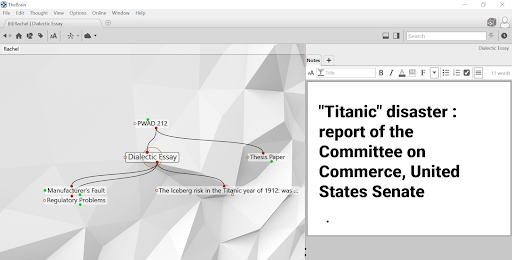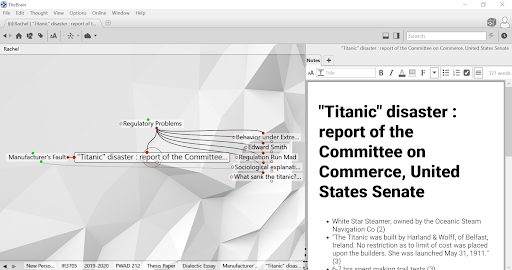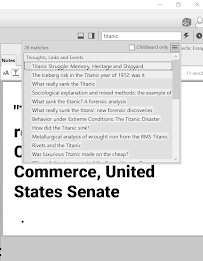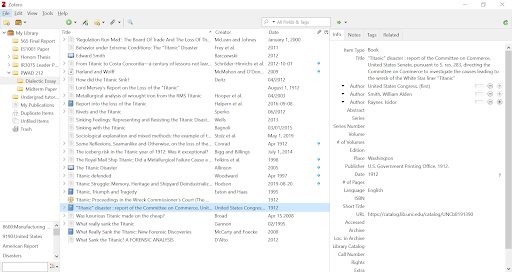TheBrain and Zotero: Tech for Research Efficiency
By a Writing Coach
TheBrain
At the end of my sophomore year, I realized that I wanted to use tech to help me write more efficiently. When I took notes for my research, I didn’t have a system that helped me organize which quotations or information went with which source. My overall disorganization made transitioning from research to writing a bit of a pain. I could never cite quickly.
That all changed when I found my dynamic duo: TheBrain and Zotero. TheBrain is a free mind-mapping, personal database (https://www.thebrain.com/). I use it exclusively for cataloging my thoughts about papers, but it could be useful for any project that involves connecting ideas. Basically, the database contains connected “thoughts,” or notes, that I create. These connections show me how thoughts relate to each other. Thoughts that are at the top of the network are “parents,” and any lower thoughts, or sub-thoughts, are “children.” Thoughts can be connected to multiple parents and multiple “siblings.”
It’s all a bit complicated, but I think an example can help explain how it works. I’ll illustrate with the method that works best for me when writing papers, which I discovered after a lot of trial and error. I create a “parent” note for the semester, with a “child” for the class, and a “child” for the paper that I’m working on. Below the paper thought, I then create a “child” note for each source that I’ve read. For example, I recently wrote about the Titanic, and I decided to use TheBrain to organize my research. I wanted to investigate whether the Titanic sank due to regulatory problems or as the result of manufacturing issues. In this case, my “parent thought” was “Dialectic Essay,” and the “children” were my two ideas, “Manufacturer’s Fault” and “Regulatory Problems.” After organizing my materials this way, I could sort all the sources I found under one of these subtopics.

The reason TheBrain is so powerful for my research is that I can put the title of the article both in the thought name and in the beginning of the written text. Then, as I read, I can take detailed notes in the article, including the page number! This process makes for super easy referencing once I go to draft. As the following screenshot shows, one thought can connect to several others. For instance, I marked the document “Titanic” Disaster: Report of the Committee on Commerce, United States Senate as being about both “Regulatory Problems” and “Manufacturer’s Fault.” These labels helped me draw connections while I wrote the essay.

Because I can search for words in my text, TheBrain functions as a powerful database. And because all of the information lives on the cloud, there is no possibility of losing all my research. I’ve had it happen before, and now I don’t have to worry about it happening again.

On its own, TheBrain provides the tools I need to connect ideas and track my sources. I often make each of these thoughts its own topic in the paper, with lists of facts and sources related to that topic. For this paper, I would write one section on manufacturing issues and another on regulatory problems. After I’ve filled in each of these thoughts, I stand back to look at my mind map. What do I see? A rough outline for my paper! In this way, TheBrain becomes a virtual version of our video on Drawing Relationships.
TheBrain and Zotero
I have found, though, that TheBrain is even more powerful when used with Zotero. As soon as I’ve found a source I want to read, I add it as a citation to my Zotero folder for the paper I’m writing. I then paste the name of the article in the relevant thought in TheBrain, along with any notes I’ve taken on that source. When I write the paper, I only need to search for the name of the article in Zotero—I already have all the citation information I need. Let’s look back at that Committee on Commerce source. I have the citation in my Zotero library, under my “Dialectic Essay” folder. Because I noted the page numbers for each piece of information as I took notes in TheBrain, I almost never need to go back to the source itself. If I do consult the source again—maybe I want to double check a figure—Zotero has saved the link for me.

These programs definitely have a steep learning curve, and it took me a bit of time before I figured out a system that really worked for me. But in the two years since I started using these tools, I finally feel as though my tech is working for me. No more scrambling for notes. No more pouring over highlighted material. Now I’m TheBrain in charge.
This blog showcases the perspectives of UNC Chapel Hill community members learning and writing online. If you want to talk to a Writing and Learning Center coach about implementing strategies described in the blog, make an appointment with a writing coach or an academic coach today. Have an idea for a blog post about how you are learning and writing remotely? Contact us here.

